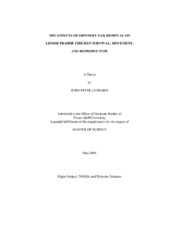| dc.description.abstract | The lesser prairie chicken (Tympanuchus pallidicinctus; LPC) has declined in
numbers since the late 1800s. Reasons for this decline have been attributed to habitat
degradation (decreased forb and grass cover and increased woody cover) and
fragmentation caused by overgrazing and conversion of native rangelands to croplands.
The herbicide, Tebuthiuron, has been used extensively throughout the LPC’s range to
reduce dominance of woody shrubs and allow growth of forbs and grasses. Tebuthiuron
treatment of shinnery oak (Quercus havardii) rangelands has been reported as being both
beneficial and detrimental to LPC populations. My study evaluated the effects of
Tebuthiuran treatment of shinney oak on LPC survival, movement, and reproduction.
I trapped (48), radio-tagged (38), and monitored LPC survival, movements,
reproduction, and habitat use during spring and summer 2006 and 2007. I also
determined potential LPC nest predators using dummy nests (domestic chicken eggs)
and motion-sensitive infrared cameras.
No differences were found in survival between ages, sexes, or years. Range size
did not differ by age, sex, or year. Female LPC moved greater distances from lek of capture than did males. Females nested almost exclusively in non-grazed rangeland and
under sand sagebrush (Artemisia filifolia). Nest-sites had higher obstruction of vision
(OV), higher (%) woody cover, and lower (%) bare ground than surrounding areas. All
LPC were found to use non-grazed rangeland areas more than all other vegetation types,
and to use tebuthiuron-treated, grazed areas slightly more than non-treated, grazed areas.
Non-grazed rangeland had higher OV than all other vegetation types. Tebuthiuron
treatment lowered woody plant dominance and increased forbs and grasses. Fire
reduced vegetation height and OV and increased growth of grasses and forbs, but did not
kill woody vegetation as did tebuthiuron-treatment. The most common dummy nest
predator found was the Chihuahuan raven (Corvus cryptoleucus). | en |


